Deck 9: Transportation and Assignment Models
Question
Question
Question
Question
Question
Question
Question
Question
Question
Question
Question
Question
Question
Question
Question
Question
Question
Question
Question
Question
Question
Question
Question
Question
Question
Question
Question
Question
Question
Question
Question
Question
Question
Question
Question
Question
Question
Question
Question
Question
Question
Question
Question
Question
Question
Question
Question
Question
Question
Question
Question
Question
Question
Question
Question
Question
Question
Question
Question
Question
Question
Question
Question
Question
Question
Question
Question
Question
Question
Question
Question
Question
Question
Question
Question
Question
Question
Question
Question
Question

Unlock Deck
Sign up to unlock the cards in this deck!
Unlock Deck
Unlock Deck
1/80
Play
Full screen (f)
Deck 9: Transportation and Assignment Models
1
A typical transportation problem may ask the question, "How many of X should be shipped to point E from source A?"
True
2
A "balanced problem" exists in a transportation model when the optimal solution has the same amount being shipped over all paths that have any positive shipment.
False
3
In a transportation problem, a single source may supply something to all destinations.
True
4
In a transportation problem, a dummy source is given a zero cost, while in an assignment problem, a dummy source is given a very high cost.

Unlock Deck
Unlock for access to all 80 flashcards in this deck.
Unlock Deck
k this deck
5
The transportation algorithm can be used to solve both minimization problems and maximization problems.

Unlock Deck
Unlock for access to all 80 flashcards in this deck.
Unlock Deck
k this deck
6
In using the stepping-stone method, the path can turn at any box or cell that is unoccupied.

Unlock Deck
Unlock for access to all 80 flashcards in this deck.
Unlock Deck
k this deck
7
One of the advantages of the stepping-stone method is that if, at a particular iteration, we accidentally choose a route that is not the best, the only penalty is to perform additional iterations.

Unlock Deck
Unlock for access to all 80 flashcards in this deck.
Unlock Deck
k this deck
8
The objective of an assignment problem solution most often is to minimize the total costs or time of performing the assigned tasks.

Unlock Deck
Unlock for access to all 80 flashcards in this deck.
Unlock Deck
k this deck
9
It is possible to find an optimal solution to a transportation problem that is degenerate.

Unlock Deck
Unlock for access to all 80 flashcards in this deck.
Unlock Deck
k this deck
10
Assignment problems involve determining the most efficient assignment of people to projects, salesmen to territories, contracts to bidders, and so on.

Unlock Deck
Unlock for access to all 80 flashcards in this deck.
Unlock Deck
k this deck
11
A solution to the transportation problem can become degenerate at any iteration.

Unlock Deck
Unlock for access to all 80 flashcards in this deck.
Unlock Deck
k this deck
12
The Hungarian method is designed to solve transportation problems efficiently.

Unlock Deck
Unlock for access to all 80 flashcards in this deck.
Unlock Deck
k this deck
13
Transportation and assignment problems are really linear programming techniques called network flow problems.

Unlock Deck
Unlock for access to all 80 flashcards in this deck.
Unlock Deck
k this deck
14
The objective of a transportation problem solution is to schedule shipments from sources to destinations while minimizing total transportation and production costs.

Unlock Deck
Unlock for access to all 80 flashcards in this deck.
Unlock Deck
k this deck
15
In finding the maximum quantity that can be shipped on the least costly route using the stepping-stone method, one examines the closed path of plus and minus signs drawn and selects the smallest number found in those squares containing minus signs.

Unlock Deck
Unlock for access to all 80 flashcards in this deck.
Unlock Deck
k this deck
16
Using the stepping-stone method to solve a maximization problem, we would choose the route with the largest positive improvement index.

Unlock Deck
Unlock for access to all 80 flashcards in this deck.
Unlock Deck
k this deck
17
In a transportation problem, each destination must be supplied by one and only one source.

Unlock Deck
Unlock for access to all 80 flashcards in this deck.
Unlock Deck
k this deck
18
In the assignment problem, the costs for a dummy row will be equal to the lowest cost of the column for each respective cell in that row.

Unlock Deck
Unlock for access to all 80 flashcards in this deck.
Unlock Deck
k this deck
19
Transportation models may be used when a firm is trying to decide where to locate a new facility.

Unlock Deck
Unlock for access to all 80 flashcards in this deck.
Unlock Deck
k this deck
20
Maximization assignment problems can easily be converted to minimization problems by subtracting each rating from the largest rating in the table.

Unlock Deck
Unlock for access to all 80 flashcards in this deck.
Unlock Deck
k this deck
21
What is said to exist when total demand equals total supply in a transportation problem?
A) an equalized problem
B) an equilibrialized problem
C) a harmonized problem
D) a balanced problem
E) This situation can never occur.
A) an equalized problem
B) an equilibrialized problem
C) a harmonized problem
D) a balanced problem
E) This situation can never occur.

Unlock Deck
Unlock for access to all 80 flashcards in this deck.
Unlock Deck
k this deck
22
When using a general LP model for transportation problems, if there are 4 sources and 3 destinations, which of the following statements is true?
A) There are typically 4 decision variables and 3 constraints.
B) There are typically 12 decision variables and 7 constraints.
C) There are typically 7 decision variables and 7 constraints.
D) There are typically 12 decision variables and 12 constraints.
E) There are typically 12 decision variables and 3 constraints.
A) There are typically 4 decision variables and 3 constraints.
B) There are typically 12 decision variables and 7 constraints.
C) There are typically 7 decision variables and 7 constraints.
D) There are typically 12 decision variables and 12 constraints.
E) There are typically 12 decision variables and 3 constraints.

Unlock Deck
Unlock for access to all 80 flashcards in this deck.
Unlock Deck
k this deck
23
Table 9-3 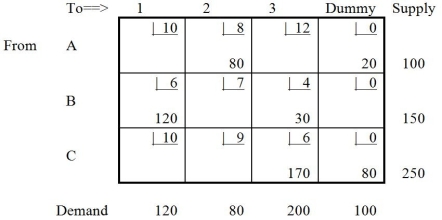 The following improvements are proved for Table 9-3:
The following improvements are proved for Table 9-3: 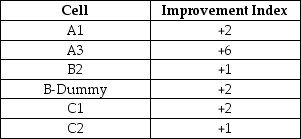
In Table 9-3, suppose shipping cost from source C to point 2 was 8, which below would be true?
A) There would be multiple optimal solutions.
B) The minimum possible total cost would decrease.
C) The minimum possible total cost would increase.
D) Another dummy column would be needed.
E) None of the above
 The following improvements are proved for Table 9-3:
The following improvements are proved for Table 9-3: 
In Table 9-3, suppose shipping cost from source C to point 2 was 8, which below would be true?
A) There would be multiple optimal solutions.
B) The minimum possible total cost would decrease.
C) The minimum possible total cost would increase.
D) Another dummy column would be needed.
E) None of the above

Unlock Deck
Unlock for access to all 80 flashcards in this deck.
Unlock Deck
k this deck
24
Both transportation and assignment problems are members of a category of LP techniques called ________.
A) transshipment problems
B) Hungarian problems
C) source-destination problems
D) supply and demand problems
E) network flow problems
A) transshipment problems
B) Hungarian problems
C) source-destination problems
D) supply and demand problems
E) network flow problems

Unlock Deck
Unlock for access to all 80 flashcards in this deck.
Unlock Deck
k this deck
25
Table 9-1 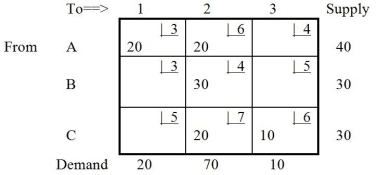
What is the value of the improvement index for cell B1 shown in Table 9-1?
A) -50
B) +3
C) +2
D) +1
E) None of the above

What is the value of the improvement index for cell B1 shown in Table 9-1?
A) -50
B) +3
C) +2
D) +1
E) None of the above

Unlock Deck
Unlock for access to all 80 flashcards in this deck.
Unlock Deck
k this deck
26
Which of the following statements concerning the transshipment problem are false?
A) The number of units shipped into a transshipment point should be equal to the number of units shipped out.
B) There can be constraints on the number of units shipped out of an origin point.
C) There can be constraints on the number of units shipped into a destination point.
D) The transshipment problem can be solved with linear programming.
E) Any units shipped from one origin point must all go to the same destination point.
A) The number of units shipped into a transshipment point should be equal to the number of units shipped out.
B) There can be constraints on the number of units shipped out of an origin point.
C) There can be constraints on the number of units shipped into a destination point.
D) The transshipment problem can be solved with linear programming.
E) Any units shipped from one origin point must all go to the same destination point.

Unlock Deck
Unlock for access to all 80 flashcards in this deck.
Unlock Deck
k this deck
27
Table 9-10 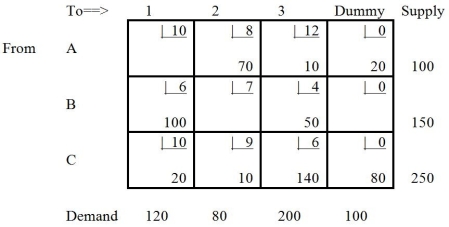
What is wrong with Table 9-10?
A) The solution is infeasible.
B) The solution is degenerate.
C) The solution is unbounded.
D) Nothing is wrong.
E) There are too many filled cells.

What is wrong with Table 9-10?
A) The solution is infeasible.
B) The solution is degenerate.
C) The solution is unbounded.
D) Nothing is wrong.
E) There are too many filled cells.

Unlock Deck
Unlock for access to all 80 flashcards in this deck.
Unlock Deck
k this deck
28
Table 9-7 
The only restriction we place on the initial solution of a transportation problem is that
A) we must have nonzero quantities in a majority of the boxes.
B) all constraints must be satisfied.
C) demand must be less than supply.
D) we must have a number (equal to the number of rows plus the number of columns minus one) of boxes that contain nonzero quantities.
E) None of the above

The only restriction we place on the initial solution of a transportation problem is that
A) we must have nonzero quantities in a majority of the boxes.
B) all constraints must be satisfied.
C) demand must be less than supply.
D) we must have a number (equal to the number of rows plus the number of columns minus one) of boxes that contain nonzero quantities.
E) None of the above

Unlock Deck
Unlock for access to all 80 flashcards in this deck.
Unlock Deck
k this deck
29
Table 9-6 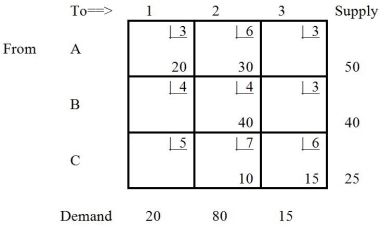
A transportation problem
A) is a special case of the linear programming problem.
B) can be solved by linear programming, but is solved more efficiently by a special-purpose algorithm.
C) may give an initial feasible solution rather than the optimal solution.
D) requires the same assumptions that are required for linear programming problems.
E) All of the above

A transportation problem
A) is a special case of the linear programming problem.
B) can be solved by linear programming, but is solved more efficiently by a special-purpose algorithm.
C) may give an initial feasible solution rather than the optimal solution.
D) requires the same assumptions that are required for linear programming problems.
E) All of the above

Unlock Deck
Unlock for access to all 80 flashcards in this deck.
Unlock Deck
k this deck
30
Table 9-13 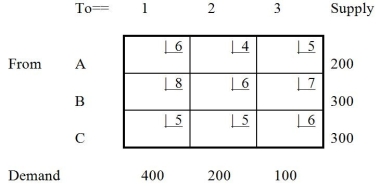
Table 9-13 provides information about a transportation problem. This problem is
A) unbounded.
B) unbalanced.
C) infeasible.
D) All of the above
E) None of the above

Table 9-13 provides information about a transportation problem. This problem is
A) unbounded.
B) unbalanced.
C) infeasible.
D) All of the above
E) None of the above

Unlock Deck
Unlock for access to all 80 flashcards in this deck.
Unlock Deck
k this deck
31
Table 9-2 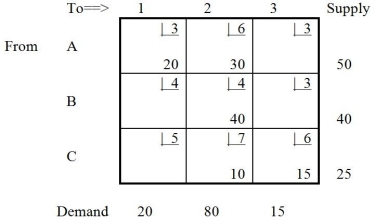
In Table 9-2, cell A3 should be selected to be filled in the next solution. If this was selected as the cell to be filled, and the next solution was found using the appropriate stepping-stone path, how many units would be assigned to this cell?
A) 10
B) 15
C) 20
D) 30
E) None of the above

In Table 9-2, cell A3 should be selected to be filled in the next solution. If this was selected as the cell to be filled, and the next solution was found using the appropriate stepping-stone path, how many units would be assigned to this cell?
A) 10
B) 15
C) 20
D) 30
E) None of the above

Unlock Deck
Unlock for access to all 80 flashcards in this deck.
Unlock Deck
k this deck
32
The two most common objectives for the assignment problem are the minimization of ________.
A) uncertainty or inexperience
B) total costs or inexperience
C) total costs or total time
D) total time or inexperience
E) total costs or uncertainty
A) uncertainty or inexperience
B) total costs or inexperience
C) total costs or total time
D) total time or inexperience
E) total costs or uncertainty

Unlock Deck
Unlock for access to all 80 flashcards in this deck.
Unlock Deck
k this deck
33
Table 9-3  The following improvements are proved for Table 9-3:
The following improvements are proved for Table 9-3: 
The cell improvement indices for Table 9-3 suggest that the optimal solution has been found. Based on this solution, how many units would actually be sent from source C?
A) 10
B) 170
C) 180
D) 250
E) None of the above
 The following improvements are proved for Table 9-3:
The following improvements are proved for Table 9-3: 
The cell improvement indices for Table 9-3 suggest that the optimal solution has been found. Based on this solution, how many units would actually be sent from source C?
A) 10
B) 170
C) 180
D) 250
E) None of the above

Unlock Deck
Unlock for access to all 80 flashcards in this deck.
Unlock Deck
k this deck
34
Table 9-7 
Table 9-7 illustrates a(n)
A) optimal solution.
B) degenerate solution.
C) unbounded solution.
D) infeasible solution.
E) None of the above

Table 9-7 illustrates a(n)
A) optimal solution.
B) degenerate solution.
C) unbounded solution.
D) infeasible solution.
E) None of the above

Unlock Deck
Unlock for access to all 80 flashcards in this deck.
Unlock Deck
k this deck
35
Table 9-11 
A company must assign mechanics to each of four jobs. The time involved varies according to individual abilities. Table 9-11 shows how many minutes it takes each mechanic to perform each job. If the optimal assignments are made, how many total minutes would be required for completing the jobs?
A) 0
B) 4
C) 17
D) 16
E) None of the above

A company must assign mechanics to each of four jobs. The time involved varies according to individual abilities. Table 9-11 shows how many minutes it takes each mechanic to perform each job. If the optimal assignments are made, how many total minutes would be required for completing the jobs?
A) 0
B) 4
C) 17
D) 16
E) None of the above

Unlock Deck
Unlock for access to all 80 flashcards in this deck.
Unlock Deck
k this deck
36
Transportation models can be used for which of the following decisions?
A) facility location
B) production mix
C) media selection
D) portfolio selection
E) employee shift scheduling
A) facility location
B) production mix
C) media selection
D) portfolio selection
E) employee shift scheduling

Unlock Deck
Unlock for access to all 80 flashcards in this deck.
Unlock Deck
k this deck
37
Table 9-12 
Given Table 9-12, the final table for an assignment problem, who should be assigned to job 2?
A) worker A
B) worker C
C) either worker A or worker C
D) neither worker A nor worker C
E) worker D

Given Table 9-12, the final table for an assignment problem, who should be assigned to job 2?
A) worker A
B) worker C
C) either worker A or worker C
D) neither worker A nor worker C
E) worker D

Unlock Deck
Unlock for access to all 80 flashcards in this deck.
Unlock Deck
k this deck
38
Table 9-1 
What is the total cost represented by the solution shown in Table 9-1?
A) 60
B) 2500
C) 2600
D) 500
E) None of the above

What is the total cost represented by the solution shown in Table 9-1?
A) 60
B) 2500
C) 2600
D) 500
E) None of the above

Unlock Deck
Unlock for access to all 80 flashcards in this deck.
Unlock Deck
k this deck
39
Table 9-6 
In Table 9-6, if cell A3 is filled on the next iteration, what is the improvement in the objective function?
A) 60
B) 30
C) 530
D) 590
E) None of the above

In Table 9-6, if cell A3 is filled on the next iteration, what is the improvement in the objective function?
A) 60
B) 30
C) 530
D) 590
E) None of the above

Unlock Deck
Unlock for access to all 80 flashcards in this deck.
Unlock Deck
k this deck
40
Which of the following is used to summarize conveniently and concisely all relevant data and to keep track of algorithm computations?
A) source-destination matrix
B) Hungarian table
C) stepping-stone grid
D) transportation table
E) tabulation report
A) source-destination matrix
B) Hungarian table
C) stepping-stone grid
D) transportation table
E) tabulation report

Unlock Deck
Unlock for access to all 80 flashcards in this deck.
Unlock Deck
k this deck
41
Which of the following is an applicable characteristic in using the stepping-stone method?
A) Only an unoccupied square may be used as a "stepping-stone."
B) Only an occupied square may be used as a "stepping-stone."
C) Only the column and row with the highest factory capacity may be used as a "stepping-stone."
D) All of the above
E) None of the above
A) Only an unoccupied square may be used as a "stepping-stone."
B) Only an occupied square may be used as a "stepping-stone."
C) Only the column and row with the highest factory capacity may be used as a "stepping-stone."
D) All of the above
E) None of the above

Unlock Deck
Unlock for access to all 80 flashcards in this deck.
Unlock Deck
k this deck
42
Table 9-15 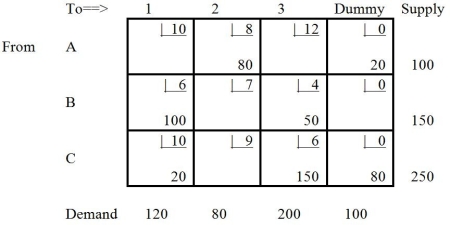
The solution shown in Table 9-15 is
A) infeasible.
B) degenerate.
C) unbounded.
D) optimal.
E) None of the above

The solution shown in Table 9-15 is
A) infeasible.
B) degenerate.
C) unbounded.
D) optimal.
E) None of the above

Unlock Deck
Unlock for access to all 80 flashcards in this deck.
Unlock Deck
k this deck
43
What is the overall objective in applying the transportation method to the facility location problem?
A) minimize the distance traveled
B) minimize the number of items shipped
C) maximize the value of items shipped
D) minimize the cost of the distribution system
E) None of the above
A) minimize the distance traveled
B) minimize the number of items shipped
C) maximize the value of items shipped
D) minimize the cost of the distribution system
E) None of the above

Unlock Deck
Unlock for access to all 80 flashcards in this deck.
Unlock Deck
k this deck
44
Which of the following accurately describes steps of the northwest corner rule, after making the initial allocation of units in the northwest cell?
A) Move down first, and then move right.
B) Move right first, and then move down.
C) Move right or down first, depending on whether the demand requirement or the supply capacity, respectively, is exhausted first.
D) Move right or down first, depending on whether the supply capacity or the demand requirement, respectively, is exhausted first.
E) Move diagonally first.
A) Move down first, and then move right.
B) Move right first, and then move down.
C) Move right or down first, depending on whether the demand requirement or the supply capacity, respectively, is exhausted first.
D) Move right or down first, depending on whether the supply capacity or the demand requirement, respectively, is exhausted first.
E) Move diagonally first.

Unlock Deck
Unlock for access to all 80 flashcards in this deck.
Unlock Deck
k this deck
45
A certain firm has four different operations that must be assigned to four locations. The profit (in thousands of dollars) associated with each operation at each location is presented below. The firm's vice president would like to assign the various operations so that the total profit is maximized. Find the appropriate assignments. 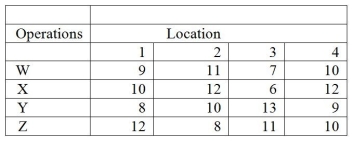


Unlock Deck
Unlock for access to all 80 flashcards in this deck.
Unlock Deck
k this deck
46
Which of the following statements concerning transportation and assignment models is false?
A) The transportation, transshipment, and assignment problems can all be solved using linear programming.
B) A common objective is cost minimization.
C) Both transportation and assignment models involve the distribution of goods from sources to destinations.
D) The assignment problem can have a maximization objective.
E) The transshipment problem is a special class of transportation problems.
A) The transportation, transshipment, and assignment problems can all be solved using linear programming.
B) A common objective is cost minimization.
C) Both transportation and assignment models involve the distribution of goods from sources to destinations.
D) The assignment problem can have a maximization objective.
E) The transshipment problem is a special class of transportation problems.

Unlock Deck
Unlock for access to all 80 flashcards in this deck.
Unlock Deck
k this deck
47
In the transportation problem, using the stepping-stone method,
A) you may not skip over an empty cell.
B) you may not skip over a used cell.
C) your path may not cross over itself.
D) if you have an optimal solution and get an improvement index of zero, there is another optimal solution.
E) None of the above
A) you may not skip over an empty cell.
B) you may not skip over a used cell.
C) your path may not cross over itself.
D) if you have an optimal solution and get an improvement index of zero, there is another optimal solution.
E) None of the above

Unlock Deck
Unlock for access to all 80 flashcards in this deck.
Unlock Deck
k this deck
48
If the total supply from the sources does not equal the total demand from the destinations in the transportation problem,
A) and if supply is greater than demand, add a dummy source or factory.
B) the amount put in a dummy source or destination should make supply and demand equal.
C) and if demand is greater than supply, add a dummy destination or warehouse.
D) All of the above
E) None of the above
A) and if supply is greater than demand, add a dummy source or factory.
B) the amount put in a dummy source or destination should make supply and demand equal.
C) and if demand is greater than supply, add a dummy destination or warehouse.
D) All of the above
E) None of the above

Unlock Deck
Unlock for access to all 80 flashcards in this deck.
Unlock Deck
k this deck
49
Which of the following techniques can be used for moving from an initial feasible solution to an optimal solution in a transportation problem?
A) Hungarian method
B) stepping-stone method
C) northwest corner rule
D) Vogel's approximation method
E) All of the above
A) Hungarian method
B) stepping-stone method
C) northwest corner rule
D) Vogel's approximation method
E) All of the above

Unlock Deck
Unlock for access to all 80 flashcards in this deck.
Unlock Deck
k this deck
50
In a transportation problem, degeneracy occurs when
A) the number of used (or full) cells does not equal the number of rows plus columns minus one.
B) in an initial solution, both a row total and a column total are satisfied simultaneously.
C) during an improvement, two negative cells contain the same smallest amount.
D) All of the above
E) None of the above
A) the number of used (or full) cells does not equal the number of rows plus columns minus one.
B) in an initial solution, both a row total and a column total are satisfied simultaneously.
C) during an improvement, two negative cells contain the same smallest amount.
D) All of the above
E) None of the above

Unlock Deck
Unlock for access to all 80 flashcards in this deck.
Unlock Deck
k this deck
51
Table 9-14 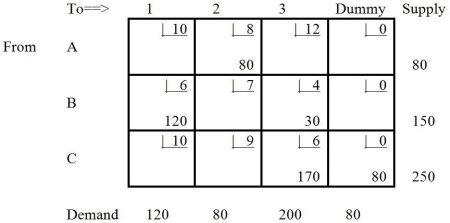
The solution presented in Table 9-14 is
A) infeasible.
B) degenerate.
C) unbounded.
D) optimal.
E) Both B and D

The solution presented in Table 9-14 is
A) infeasible.
B) degenerate.
C) unbounded.
D) optimal.
E) Both B and D

Unlock Deck
Unlock for access to all 80 flashcards in this deck.
Unlock Deck
k this deck
52
After testing each unused cell by the stepping-stone method in the transportation problem and finding only one cell with a negative improvement index,
A) once you make that improvement, you would definitely have an optimal solution.
B) you would make that improvement and then check all unused cells again.
C) you could stop because you already had the optimal solution.
D) you should check to be sure that you don't have to add a dummy source or dummy destination.
E) None of the above
A) once you make that improvement, you would definitely have an optimal solution.
B) you would make that improvement and then check all unused cells again.
C) you could stop because you already had the optimal solution.
D) you should check to be sure that you don't have to add a dummy source or dummy destination.
E) None of the above

Unlock Deck
Unlock for access to all 80 flashcards in this deck.
Unlock Deck
k this deck
53
Which technique requires that we start in the upper-left-hand cell of the table and allocate units to shipping routes in a "stair step" fashion?
A) upper-left rule
B) stair step method
C) northwest corner rule
D) Vogel's approximation method
E) MODI
A) upper-left rule
B) stair step method
C) northwest corner rule
D) Vogel's approximation method
E) MODI

Unlock Deck
Unlock for access to all 80 flashcards in this deck.
Unlock Deck
k this deck
54
In a transshipment problem involving 3 origins, 2 intermediate points, and 4 final destinations, what is the maximum number of decision variables?
A) 24
B) 9
C) 14
D) 7
E) 20
A) 24
B) 9
C) 14
D) 7
E) 20

Unlock Deck
Unlock for access to all 80 flashcards in this deck.
Unlock Deck
k this deck
55
If items being transported must go through an intermediate point before reaching a final destination, then this situation is known as a(n) ________.
A) transshipment problem
B) assignment problem
C) transportation problem
D) intermediate point problem
E) None of the above
A) transshipment problem
B) assignment problem
C) transportation problem
D) intermediate point problem
E) None of the above

Unlock Deck
Unlock for access to all 80 flashcards in this deck.
Unlock Deck
k this deck
56
Which of the following is not part of the transportation algorithm?
A) northwest corner rule
B) stepping-stone method
C) balanced transportation table
D) portfolio selection
E) Hungarian method
A) northwest corner rule
B) stepping-stone method
C) balanced transportation table
D) portfolio selection
E) Hungarian method

Unlock Deck
Unlock for access to all 80 flashcards in this deck.
Unlock Deck
k this deck
57
If we want to quickly arrive at a "feasible," but not necessarily "optimal" solution to the transportation problem, we will use the
A) stepping-stone method.
B) northwest corner rule.
C) Vogel's approximation method.
D) MODI method.
E) Any of the above
A) stepping-stone method.
B) northwest corner rule.
C) Vogel's approximation method.
D) MODI method.
E) Any of the above

Unlock Deck
Unlock for access to all 80 flashcards in this deck.
Unlock Deck
k this deck
58
When using the stepping-stone method, what is the maximum amount that can be shipped on the new route?
A) the smallest number found in the squares with minus signs
B) the smallest number found in the squares with plus signs
C) the smallest number along the closed path
D) the minimum of the demand requirement for that column and the supply capacity for that row
E) the largest number found on the squares with minus signs
A) the smallest number found in the squares with minus signs
B) the smallest number found in the squares with plus signs
C) the smallest number along the closed path
D) the minimum of the demand requirement for that column and the supply capacity for that row
E) the largest number found on the squares with minus signs

Unlock Deck
Unlock for access to all 80 flashcards in this deck.
Unlock Deck
k this deck
59
An artificial source added to a transportation table when total demand is greater than total supply is called ________.
A) excess source
B) filler source
C) dummy source
D) demand source
E) supply source
A) excess source
B) filler source
C) dummy source
D) demand source
E) supply source

Unlock Deck
Unlock for access to all 80 flashcards in this deck.
Unlock Deck
k this deck
60
Table 9-16 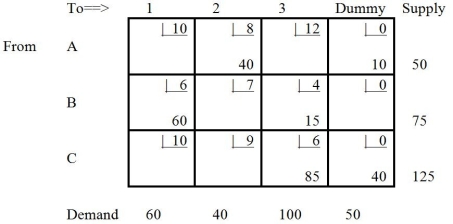
The solution shown in Table 9-16 is
A) infeasible.
B) one of a number of alternate solutions.
C) unbounded.
D) optimal.
E) None of the above

The solution shown in Table 9-16 is
A) infeasible.
B) one of a number of alternate solutions.
C) unbounded.
D) optimal.
E) None of the above

Unlock Deck
Unlock for access to all 80 flashcards in this deck.
Unlock Deck
k this deck
61
Neki Sports Company manufacturers treadmills in factories located in Pittsburgh and Kansas City. These are shipped to regional distribution centers in Chicago, Phoenix, and Philadelphia. Ultimately they are delivered to supply houses in New York and Los Angeles. The available supplies at the factories, demands at the final destinations, and shipping costs are illustrated in the table below.  Determine how many units should be shipped for all possible origin and destination points (final or intermediate) in the distribution network in order to minimize shipping costs.
Determine how many units should be shipped for all possible origin and destination points (final or intermediate) in the distribution network in order to minimize shipping costs.
 Determine how many units should be shipped for all possible origin and destination points (final or intermediate) in the distribution network in order to minimize shipping costs.
Determine how many units should be shipped for all possible origin and destination points (final or intermediate) in the distribution network in order to minimize shipping costs.
Unlock Deck
Unlock for access to all 80 flashcards in this deck.
Unlock Deck
k this deck
62
In revising the opportunity cost table of the assignment problem, after drawing lines through all of the zeros,
A) the smallest uncovered number is added to all zeros.
B) the smallest uncovered number is added to all uncovered numbers.
C) the largest uncovered number is added to all uncovered numbers.
D) the smallest uncovered number is added to all numbers at the intersection of lines.
E) the largest uncovered number is added to all numbers at the intersection of lines.
A) the smallest uncovered number is added to all zeros.
B) the smallest uncovered number is added to all uncovered numbers.
C) the largest uncovered number is added to all uncovered numbers.
D) the smallest uncovered number is added to all numbers at the intersection of lines.
E) the largest uncovered number is added to all numbers at the intersection of lines.

Unlock Deck
Unlock for access to all 80 flashcards in this deck.
Unlock Deck
k this deck
63
When is a dummy destination added to a transportation problem?

Unlock Deck
Unlock for access to all 80 flashcards in this deck.
Unlock Deck
k this deck
64
What is meant by a balanced transportation problem?

Unlock Deck
Unlock for access to all 80 flashcards in this deck.
Unlock Deck
k this deck
65
Describe a general transportation problem.

Unlock Deck
Unlock for access to all 80 flashcards in this deck.
Unlock Deck
k this deck
66
Objectives of the assignment problem can include
A) minimize total costs.
B) minimize total time to perform the tasks at hand.
C) minimize opportunity costs.
D) maximize profit.
E) All of the above
A) minimize total costs.
B) minimize total time to perform the tasks at hand.
C) minimize opportunity costs.
D) maximize profit.
E) All of the above

Unlock Deck
Unlock for access to all 80 flashcards in this deck.
Unlock Deck
k this deck
67
Four projects must be completed, and each of four employees will be assigned to work on exactly one of the four projects. The table below presents an estimate of the cost that each employee would incur if working on the respective projects. What is the minimum-cost assignment of workers to projects? 


Unlock Deck
Unlock for access to all 80 flashcards in this deck.
Unlock Deck
k this deck
68
SE Appliances manufacturers refrigerators in Richmond, Charlotte, and Atlanta. Refrigerators then must be shipped to meet demand in Washington, New York, and Miami. The table below lists the shipping costs, supply, and demand information.  How many units should be shipped from each plant to each retail store in order to minimize shipping costs?
How many units should be shipped from each plant to each retail store in order to minimize shipping costs?
 How many units should be shipped from each plant to each retail store in order to minimize shipping costs?
How many units should be shipped from each plant to each retail store in order to minimize shipping costs?
Unlock Deck
Unlock for access to all 80 flashcards in this deck.
Unlock Deck
k this deck
69
Neki Sports Company manufacturers treadmills in factories located in Pittsburgh and Kansas City. These are shipped to regional distribution centers in Chicago, Phoenix, and Philadelphia. Ultimately they are delivered to supply houses in New York and Los Angeles. The available supplies at the factories, demands at the final destinations, and shipping costs are illustrated in the table below.  Formulate this problem as a linear program.
Formulate this problem as a linear program.
 Formulate this problem as a linear program.
Formulate this problem as a linear program.
Unlock Deck
Unlock for access to all 80 flashcards in this deck.
Unlock Deck
k this deck
70
Which tableau is the solution to the transportation problem depicted below?Table 9-17 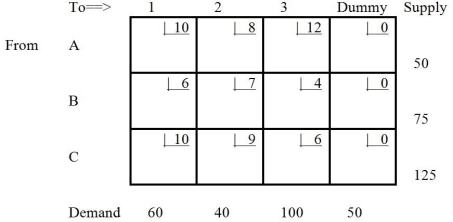 A)
A) 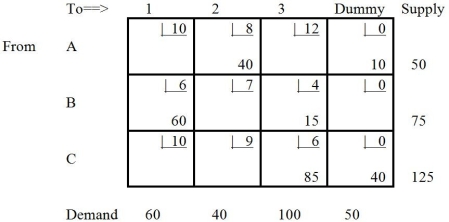 B)
B) 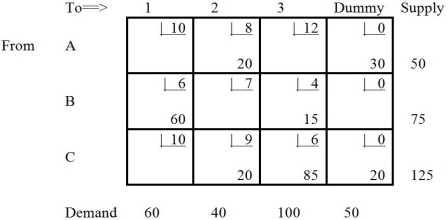 C)
C) 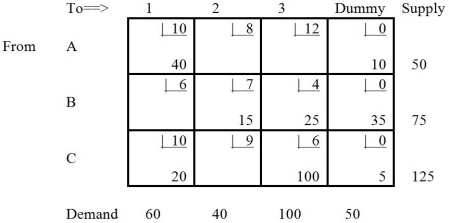 D)
D) 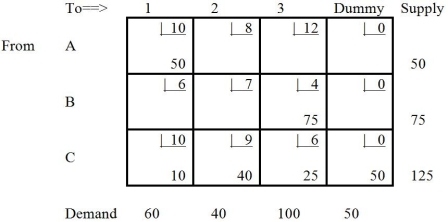 E) None of the above
E) None of the above
 A)
A)  B)
B)  C)
C)  D)
D)  E) None of the above
E) None of the above
Unlock Deck
Unlock for access to all 80 flashcards in this deck.
Unlock Deck
k this deck
71
In solving maximization assignment problems,
A) just reverse all the decision rules used in the minimizing algorithm (if it says subtract, now add, and so on).
B) convert the problem to an equivalent minimization problem.
C) use the Australian transformation process and convert the data.
D) All of the above
E) None of the above
A) just reverse all the decision rules used in the minimizing algorithm (if it says subtract, now add, and so on).
B) convert the problem to an equivalent minimization problem.
C) use the Australian transformation process and convert the data.
D) All of the above
E) None of the above

Unlock Deck
Unlock for access to all 80 flashcards in this deck.
Unlock Deck
k this deck
72
Table 9-19 describes a transportation problem:Table 9-19 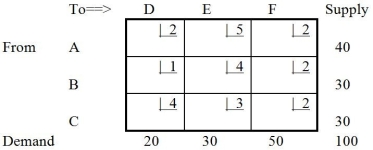 (a) Use the northwest corner method to get an initial solution.
(a) Use the northwest corner method to get an initial solution.
(b) What is the cost of the initial solution?
(c) Use the stepping-stone method to find the optimal solution.
(d) What is the cost of the optimal solution?
(e) Is there an alternate optimal solution?
 (a) Use the northwest corner method to get an initial solution.
(a) Use the northwest corner method to get an initial solution.(b) What is the cost of the initial solution?
(c) Use the stepping-stone method to find the optimal solution.
(d) What is the cost of the optimal solution?
(e) Is there an alternate optimal solution?

Unlock Deck
Unlock for access to all 80 flashcards in this deck.
Unlock Deck
k this deck
73
The assignment problem is a special case of the transportation problem. So, then, why is it not recommended to use the transportation algorithm to solve the assignment problem?

Unlock Deck
Unlock for access to all 80 flashcards in this deck.
Unlock Deck
k this deck
74
Why don't we want to use the transportation algorithm to solve the assignment problem?
A) It would likely lead to an unbounded solution.
B) It would likely lead to a degenerate solution.
C) It would likely lead to an infeasible solution.
D) It would likely lead to multiple optima.
E) It would likely lead to an unbalanced solution.
A) It would likely lead to an unbounded solution.
B) It would likely lead to a degenerate solution.
C) It would likely lead to an infeasible solution.
D) It would likely lead to multiple optima.
E) It would likely lead to an unbalanced solution.

Unlock Deck
Unlock for access to all 80 flashcards in this deck.
Unlock Deck
k this deck
75
Which tableau is the solution to the following transportation table?Table 9-18 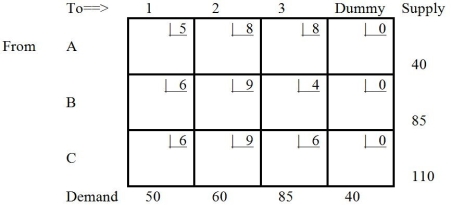 A)
A)  B)
B) 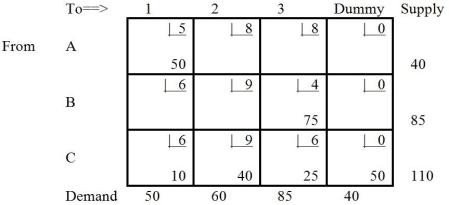 C)
C) 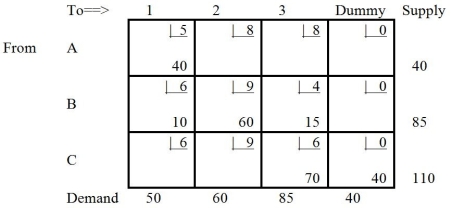 D)
D) 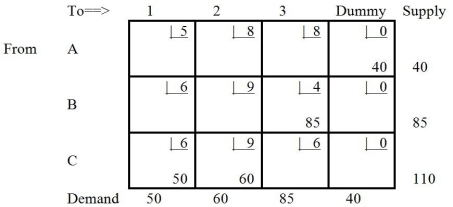 E) None of the above
E) None of the above
 A)
A)  B)
B)  C)
C)  D)
D)  E) None of the above
E) None of the above
Unlock Deck
Unlock for access to all 80 flashcards in this deck.
Unlock Deck
k this deck
76
Which of the following is not considered a special situation with the transportation algorithm?
A) unbalanced transportation problems
B) degeneracy
C) unconstrained transportation problems
D) more than one optimal solution
E) maximization transportation problems
A) unbalanced transportation problems
B) degeneracy
C) unconstrained transportation problems
D) more than one optimal solution
E) maximization transportation problems

Unlock Deck
Unlock for access to all 80 flashcards in this deck.
Unlock Deck
k this deck
77
Which of the following is not a step in the Hungarian method of assignment?
A) find the opportunity-cost table
B) test for an optimal assignment
C) enumerate all possible solutions
D) revise the opportunity-cost table
E) None of the above
A) find the opportunity-cost table
B) test for an optimal assignment
C) enumerate all possible solutions
D) revise the opportunity-cost table
E) None of the above

Unlock Deck
Unlock for access to all 80 flashcards in this deck.
Unlock Deck
k this deck
78
Practically speaking, multiple optimal solutions ________.
A) are infeasible
B) are unbounded
C) are degenerate
D) are unbalanced
E) provide management with greater flexibility in selecting and using resources
A) are infeasible
B) are unbounded
C) are degenerate
D) are unbalanced
E) provide management with greater flexibility in selecting and using resources

Unlock Deck
Unlock for access to all 80 flashcards in this deck.
Unlock Deck
k this deck
79
In an assignment problem
A) the number of rows and columns must be equal.
B) the number of rows must exceed the number of columns.
C) the number of rows must equal or exceed the number of columns.
D) the number of columns must equal or exceed the number of rows.
E) None of the above
A) the number of rows and columns must be equal.
B) the number of rows must exceed the number of columns.
C) the number of rows must equal or exceed the number of columns.
D) the number of columns must equal or exceed the number of rows.
E) None of the above

Unlock Deck
Unlock for access to all 80 flashcards in this deck.
Unlock Deck
k this deck
80
Which of the following methods is used only with the assignment problem?
A) the Hungarian method
B) stepping-stone method
C) MODI method
D) Vogel's approximation method
E) the simplex method
A) the Hungarian method
B) stepping-stone method
C) MODI method
D) Vogel's approximation method
E) the simplex method

Unlock Deck
Unlock for access to all 80 flashcards in this deck.
Unlock Deck
k this deck



